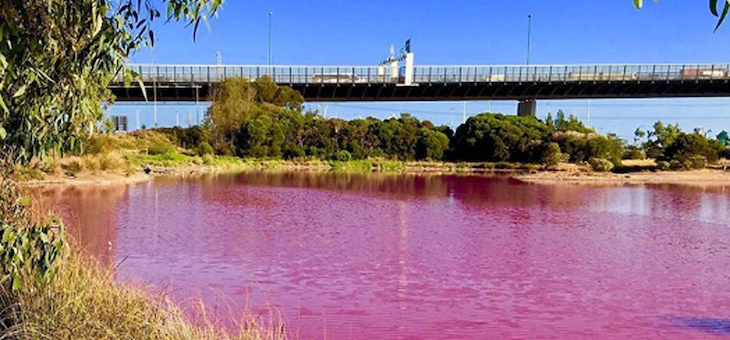Tourists and locals alike flood to Westgate Park in Melbourne each summer to witness one of the most spectacular sights. The water in the park lake turns bright pink in summer as if victim to an industrial paint spill. Thankfully, the phenomenon is natural.
Why does it turn pink?
One of the key players in the colour change is salt. The man-made salt lake was built to replace the original saltmarsh that was there and so already contained large amounts of the mineral in the water. But it only turns pink when salt levels are higher than normal. High temperatures, lots of sunlight, and a lack of rainfall are also needed.
It’s in these conditions that algae growing in the lake’s salt crust produce a red pigment, called beta carotene, as part of their photosynthesis process. The result: a spectacular deep pink lake.
It first turned pink in December 2012 and has done so almost every summer since, staying that way until later in autumn when it returns to being blue as the weather cools down and rainfall increases.
Other pink lakes in Australia
Luckily, Australia is home to many natural wonders. In a country that boasts everything from the Great Barrier Reef to Uluru, from limestone caves to snow-covered mountains, bubblegum pink lakes don’t seem that far-fetched.
Lake Hillier, Middle Island, Western Australia
Perhaps Australia’s most famous pink lake. It’s unlike many other pink lakes in Australia as it stays the same vibrant, lipstick pink colour all year round.
Hutt Lagoon, Western Australia
Around 500km north of Perth sits Hutt Lagoon, a pink lake that stretches over an impressive 70km. The colour of Hutt Lagoon can actually vary from lilac to bright pink and can even seem silver. It just depends on the weather, cloud cover, and the time of day.
Lake Crosbie, Lake Becking, Lake Kenyon and Lake Hardy, Victoria
Four pink lakes lie in the Murray-Sunset National Park, located 50km south of Mildura in North West Victoria. The colours range from mauve to the classic bubblegum pink after rainfall.
Lake Eyre, South Australia
Sitting an eight-hour drive north of Adelaide is Lake Eyre, Australia’s largest salt lake. Unfortunately, it’s one of the harder scenes to enjoy as floodwaters only cover the lake once every eight years on average. In fact, the lake has only filled to capacity three times in the past 160 years.
Although the water is not dangerous, people are advised not to go for a dip in Westgate Park lake. It may look like a mixture of candy floss, strawberry milkshake and bubblegum, but the super-high salt levels can irritate your skin.
In fact, you might not want to get too close at all – the lake surface gives off a whiff of eggs.
Have you visited any pink lakes in Australia? Are any on your travel list?
— With PA
If you enjoy our content, don’t keep it to yourself. Share our free eNews with your friends and encourage them to sign up.
Related articles:
https://www.yourlifechoices.com.au/travel/destinations/melbournes-five-best-views https://www.yourlifechoices.com.au/travel/destinations/most-beautiful-flower-fields https://www.yourlifechoices.com.au/travel/destinations/worlds-most-surreal-landscapes

